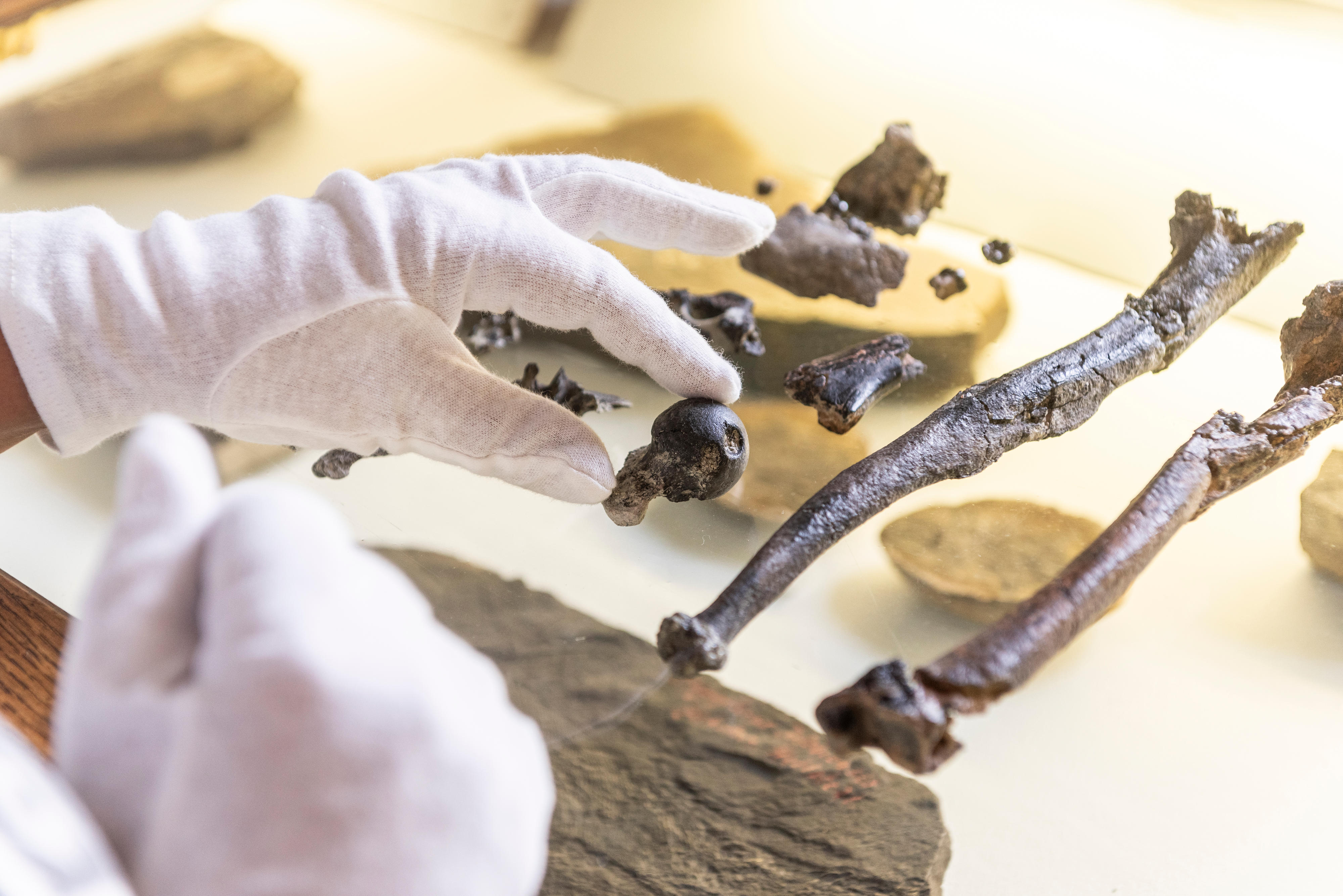Ancient Ape with 'Human Legs' and 'Orangutan Arms' Moved Like No Other Creature on Earth
This weird locomotion has never been seen until now.

More than 11 million years ago, an oddball ape equipped with human-like legs and robust ape-like arms clambered across tree limbs, possibly escaping feline predators. That's the picture that scientists have gleaned about a new species of fossil ape discovered in Bavaria.
The ape creature may have also used a weird locomotion never seen until now, shedding light on how the ancestors of humans may have evolved to walk on two legs, a new study finds.
These findings may also yield insights on how the ancestors of modern great apes evolved to favor their arms for movement, the researchers added.
Related: In Photos: 13-Million-Year-Old Primate Skull Discovered
A key trait distinguishing humans from our closest living relatives — modern great apes, including chimpanzees, bonobos, gorillas and orangutans — is how we stand upright and walk on our feet. This bipedal posture ultimately helped free our hands for tool use, helping humanity spread across the planet.
In contrast, modern great apes possess elongated arms they use during movement. For example, chimpanzees, bonobos and gorillas practice knuckle-walking, whereas orangutans walk using their fists on the ground, and all modern great apes have anatomical traits that let them swing from branch to branch using only their arms — a locomotion method called brachiation.
Much remains uncertain about the origin of locomotion in hominins — the group of species that includes humans and their relatives after their split from the chimpanzee lineage — because scientists have lacked the appropriate fossil evidence. Previous research has suggested that humans evolved from a four-legged animal that either placed the palms of their hands and soles of their feet on the ground as they walked, similar to living monkeys, or favored suspending their bodies from trees as they moved, similar to modern chimpanzees.
Get the world’s most fascinating discoveries delivered straight to your inbox.
Related: In Photos: Hominin Skulls with Mixed Traits Discovered
Since the 1970s, paleontologists have unearthed many fossils of ape species from Europe and Africa, from the middle to late Miocene epoch about 13 million to 5.3 million years ago, when they think the ape and human lineages diverged. However, none of these fossils preserved completely intact limb bones, limiting how much insight researchers could glean regarding how these ancient species moved.
Now, scientists have unearthed a new fossil great ape with complete limb bones that lived during the Miocene about 11.62 million years ago in what is now Bavaria in Germany.
The paleontologists named the species Danuvius guggenmosi. "Danuvius" is derived from the Celtic-Roman river god Danuvius, and "guggenmosi" honors Sigulf Guggenmos, who discovered the site where the fossil was found.
Intriguingly, "Danuvius is like an ape and a hominin in one," study lead author Madelaine Böhme, a paleontologist at the Eberhard Karls University of Tübingen in Germany, told Live Science.
The researchers estimated Danuvius weighed between 37 and 68 lbs. (17 and 31 kilograms). The males would have been larger than the females, suggesting Danuvius favored polygyny, where males had multiple female mates, Böhme said.
When Danuvius was alive, the area where it was found was a hot, flat landscape with forests alongside meandering rivers not far from the edges of the Alps, Böhme said. Its teeth revealed that it belonged to a group of fossil ape species called dryopithecines that some previous research suggested might be the ancestors of modern African apes. The thick enamel on its teeth suggests that Danuvius ate hard items, she noted.
The slightly elongated arms of the four or more specimens of Danuvius that the scientists unearthed suggested that it could hang from trees just like modern great apes. Still, its finger bones were not as robust as one would expect of knuckle-walkers.

In addition, unlike other apes, such as gibbons and orangutans, which don't use their legs as much as their arms for movement, Danuvius would have held its legs straight and could have walked upright while moving around in trees. Danuvius also had a grasping big toe, which meant it would have walked on its soles. Moreover, its elbows, lower spine and shin bones were more like one might expect of a human, Böhme said.
All in all, Danuvius didn't favor either its arms or legs in movement, but appeared to use both about equally, the researchers said. Böhme and her colleagues suggested this newly identified type of locomotion, which they dubbed "extended limb clambering," may be the ancestral form of movement for both modern great apes and humans.
It remains uncertain why Danuvius didn't favor either its arms or legs. Perhaps, Danuvius used its long, strong and opposable big toes to "clamber" quickly along tree limbs to escape larger cats, which are excellent tree-climbing predators, the researchers speculated.
"Danuvius could, in contrast to apes and humans, therefore securely grasp with his foot very small-diameter supports, letting him somehow stand in a thicket of lianas and thin branches," Böhme said. "Into this microhabitat, no cat can follow."
Danuvius is one of the most common large fossil mammals the researchers have discovered at this site, so they look forward to discovering more specimens of the species to shed light on how it might have lived. "I'm sure the forthcoming years will bring new spectacular discoveries," Böhme said.
The scientists detailed their findings in the Nov. 7 issue of the journal Nature.
- Photos: Earliest Known Human Fossils Discovered
- In Photos: Amazing Human Ancestor Fossils from Dmanisi
- In Photos: Oldest Homo Sapiens Fossils Ever Found
Originally published on Live Science.

